Windows 7 Users Will Soon Start Seeing a Windows 7 End-of-Life Notification
Many of you are still using Windows 7 – and that’s fine. You still have until January 2020 to use Windows 7 safely. This is a heads up for all Windows 7 users about a new Windows 7 End-of-Life notification that’s coming your way soon.
Starting on April 18, 2019, Windows 7 users will begin seeing periodic notifications reminding them that Windows 7 will reach its end-of-life on January 14, 2020. The notifications will contain a “Learn more” link to a Microsoft page which contains information about the end of support for Windows 7 and recommending Windows 7 users upgrade to Windows 10.
The “Learn more” page says, among other things:
“…While you could continue to use your PC running Windows 7, without continued software and security updates, it will be at greater risk for viruses and malware. Going forward, the best way for you to stay secure is on Windows 10. And the best way to experience Windows 10 is on a new PC. While it is possible to install Windows 10 on your older device, it is not recommended…”
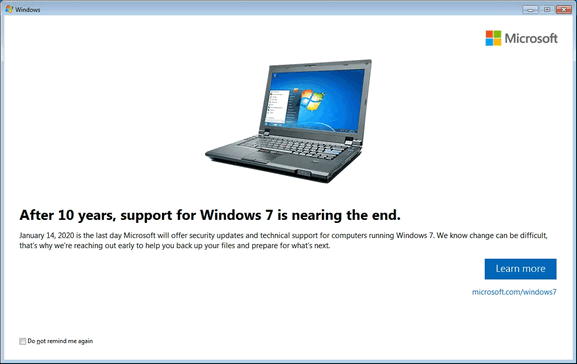
The text in the notification above reads as follows:
After 10 years, support for Windows 7 is nearing the end.
January 14, 2020, is the last day Microsoft will offer security updates and technical support for computers running Windows 7. We know change can be difficult, that’s why we’re reaching out early to help you back up your files and prepare for what’s next.
If you don’t want to keep receiving these Windows 7 End-of-Life notifications, keep on reading.
Don’t want to keep receiving these End-of-Life notifications? Then be sure to check the box next to “Do not remind me again.”
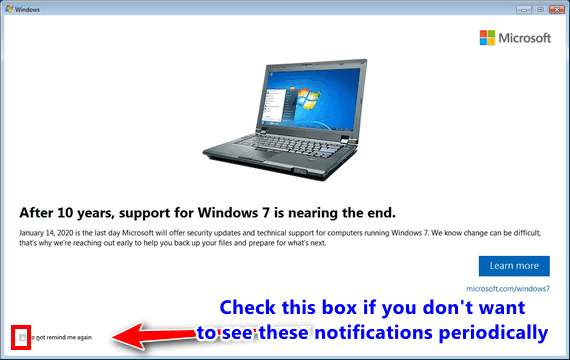
Below: A close-up. Check the box just to the left of “Do not remind me again” if you don’t want to see these notifications pop-up on your computer periodically.
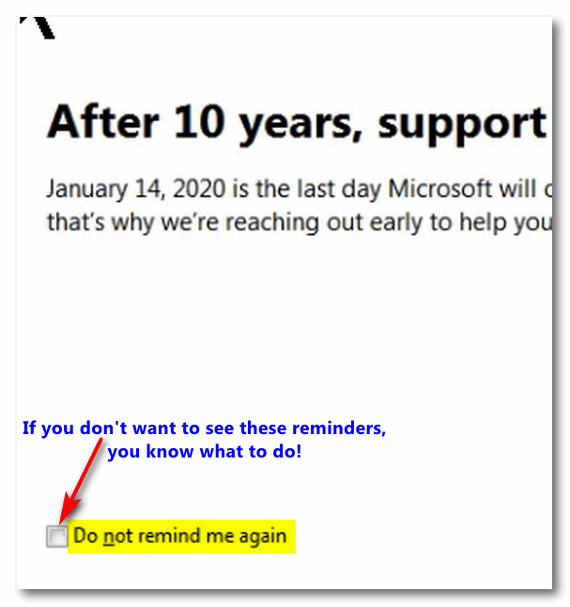
If you prefer not to install this update at all, open Windows Update in Control Panel and set Windows Update to “Check for updates but let me choose whether to download and install them”. When you see that KB4493132 waiting for installation, be sure you don’t install it.
If it the update does get installed somehow, go to Control Panel > Programs & Features and click on “View installed updates” on the menu o the left.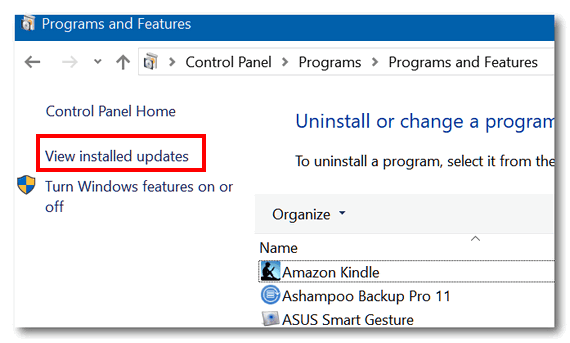
Find KB4493132 in the list of installed updates and double-click on it. Confirm you want to uninstall it by clicking “Yes”.
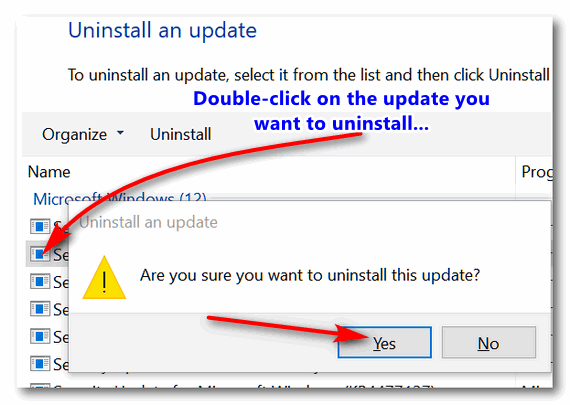
If you don’t stop these notifications will continue to pop up on your Windows 7 computer.
Forewarned is forearmed. If you’re using Windows 7 you can use it safely until January 14, 2019. Although Microsoft has never announced it officially you can still upgrade to Windows 10 free, see our article here.


Seems to me that Microsoft was going to continue installing updates for a fee if so desired.
Only for Windows 10 Professional and Windows 10 Enterprise and only if you’re running a business. The update extension does not apply to Windows 10 Home or home users. But even if it did, a home user could go out and buy several new computers for what one year of updates would cost you. It wouldn’t make any kind of financial sense because, despite all the negative people, Windows 10 is not that much different from Windows 7.
Is Windows 10 ever going to be stable? I feel like I’m always reading there are so many problems with it and that’s the main reason I’m still using Windows 7. When the time comes, I guess I’ll have to switch. Right now, I’m using Win 7 Pro, and based on that, I was wondering what version of Windows 10 you would recommend? Thanks so much!
People who are satisfied are notoriously silent. Those who have problems tend to make up for the silence of the majority. There are about 800,000,000 users of Windows 10 – so even if 10 million of them are having problems, but they’re vocal, they’re going to drown out the silence of those who have no problem. We can tell you from experience, Windows 10 is far more stable than any previous version of Windows 10. People look back with nostalgic reflection on Windows XP, but we repair computers and we can tell you that Windows XP, while far better than its predecessors (Windows 95, Windows 98, Windows 98SE, Windows ME), had its share of problems. And Windows 7 had a flawed update system. No Windows is ever going to be perfect, but Windows 10 is far better than some would like you to believe.
If you’re using Windows 7 Pro you can still get Windows 10 Pro free by upgrading from Windows 7 to Windows 10. If your compter is too old to upgrade, you’ll save a lot of money using Windows 10 Home. We have one Windows 10 Pro computer, and if we were not in the business we’re in we’d not have it. The only thing we use on Windows 10 is the group policy editor (GPE) and there’s even a way to install it on Windows 10 Home.
It’s hard not to listen to the naysayers, they’re loud. But Darcy and I have been fixing computers all the way back to Windows 98… and Windows 10 is the best Windows yet (our opinion), but it’s not perfect.
I have Windows 7 Pro, but not sure if it’s too old to upgrade to 10.
How can I tell ?
Also, would the upgrade to 10 be Pro version, not that I care. 🙂 Just curious
Hi Jill,
If you have Windows 7 Pro you would automatically be upgraded to Windows 10 Pro. There’s no really accurate way to tell if your computer can run Windows 10 other than trying to install the update. If your computer won’t support Windows 10, the upgrade will roll back and you’ll be back to Windows 7. We would still advise you to make a backup of your important files, just in case.
I have a newer ASUS computer and a Dell that is almost 7 years old. I upgraded the Dell computer from Windows 7 to Windows 10 and that 7-year-old laptop runs better with Windows 10 on it than it ever did with Windows 7. It runs better than my 3-year-old Asus too
So, if you want to find out if your computer can run Windows 10, best thing I can tell you is try the upgrade, if it fails, you’ll be left with what you have now – and at least you’ll know your computer can’t run Windows 10.
Here’s our article on doing the free upgrade from Windows 7 to Windows 10.
Thanks!
Best wishes,
TC
Thanks for your words of wisdom. Now I’m curious about Windows 10 Pro and your comments about not upgrading to it. Did you already write an article about that? If not, could you expand on that comment a little here? Thanks again!
We never said not to upgrade to Windows 10 Pro. What was said was if you are running Windows 7 Pro and you upgrade to Windows 10 via the Microsoft Windows 10 Upgrade site, you’ll automatically get Windows 10 Pro. What we said was that if your older Windows 7 computer is not capable of running Windows 10, we recommend that people don’t spend the extra money for Windows 10 Pro if they are going out to purchase a new computer. I hope this clears things up for you.
Thank you again. Didn’t mean to construe your words, but I guess I wasn’t sure what you meant by your comment “We have one Windows 10 Pro computer, and if we were not in the business we’re in we’d not have it.” regarding Windows 10 Pro.
*misconstrue, sorry.